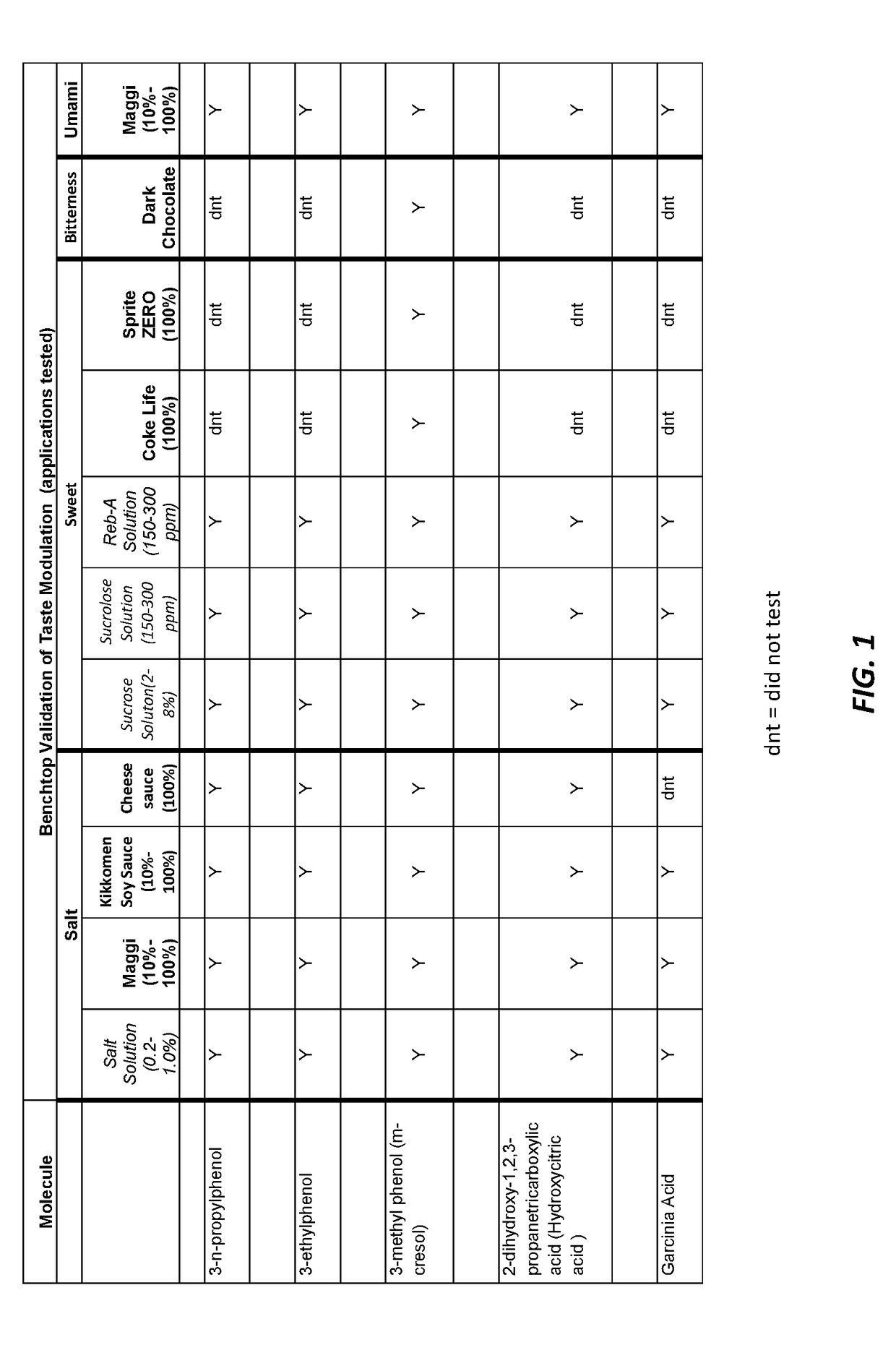Composition comprising taste modulation compounds, their use and foodstuff comprising them
a technology of modulation compounds and compounds, applied in the direction of cocoa, food ingredients as flavour affecting agents, food ingredients as taste affecting agents, etc., can solve the problem of restricted use of this compound
- Summary
- Abstract
- Description
- Claims
- Application Information
AI Technical Summary
Benefits of technology
Problems solved by technology
Method used
Image
Examples
example 1
and 3-n-Propylphenol Added to Cheese Sauce
[0035]Five expert tasters consumed the Control and then cheese sauce comprising the different flavour modifying compounds. The presence of the different flavour modifying compounds lead to an increased perception of saltiness and increased salivation.
TABLE 1Various Mixtures of 3-n-propylphenol and m-cresol added to cheese SauceTreatment IDControl12AB34Formula:Cheese sauce alone100 QS100QS100QS100QS100QS100QS100with added 3-n-propylphenol, ppb00.010.010 0.0100.01with added m-cresol, ppb0100100100 01000Result:Salivation effectnoyesyesyesyesyesyesSaltiness score*1>12.5323.52.5*Saltiness score: (1 - low . . . 5 - high). Not intended to communicate a magnitude increase since these are relative intensities.
example 2
Added to Salt Condiment Mixture
[0036]Five expert tasters consumed the Control and then salt condiment mixtures with 100 ppb of m-cresol. It was shown that m-cresol amplifies saltiness and suppresses bitterness. When sodium is absent, as in the no-salt product, no modulation was witnessed. Since, saltiness from sodium chloride and bitterness from potassium chloride is multi-modally modulated with taste modulating chemistries, blends of sodium chloride with potassium chloride are perceived as saltier with reduced bitterness.
TABLE 2m-cresol added to Salt Condiment Mixturesm-cresol,ItemControl100 ppbCommentsMorton ®SaltyExcellentm-cresolLite SaltMineralenhancementamplification(50%Dirtyof saltinessoflessBitterLess dirtysaltinesssodium)†Much lessandused atbittersuppression0.75%of bitteris obvious.Results:No salt,BitterBitter,Nosodium-SourSourEffect -free salt‡AcidicAcidicthere is noused atSlightlySlightly saltysodium to0.75%saltyDirtymodulate -Dirtybitter / sourResults:Same as Control†Morto...
example 3
Screening Tests
[0037]The following flavour modifying compounds have been tested (alone) in bench top screening tests: m-cresol, 3-n-propylphenol, 3-ethylphenol, hydroxycitric acid, and garcinia acid. The following taste modulations have been tested: salt enhancement, sweet enhancement, bitterness reduction, umami enhancement.
[0038]Salt—Model Salt Solution—[Ranged from 0.2%-1.2% Salt]
[0039]Sodium chloride (NaCl) solutions were used as a source of a liquid salt model. NaCl solutions were evaluated without and with a water based solution of flavour modifying compound, typically at 5 ppm concentration when the flavour modifying compound is chosen between hydroxycitric acid, and garcinia acid. M-cresol, 3-n-propylphenol, and 3-ethylphenol are respectively used at a 0.001 ppm, 0.00001 ppm and 0.001 ppm concentrations. Up to five expert tasters consumed 1 g of NaCl solution alone (control), followed by 1 g of NaCl solution dosed with the different flavour modifying compounds. Comparison of...
PUM
 Login to View More
Login to View More Abstract
Description
Claims
Application Information
 Login to View More
Login to View More - R&D
- Intellectual Property
- Life Sciences
- Materials
- Tech Scout
- Unparalleled Data Quality
- Higher Quality Content
- 60% Fewer Hallucinations
Browse by: Latest US Patents, China's latest patents, Technical Efficacy Thesaurus, Application Domain, Technology Topic, Popular Technical Reports.
© 2025 PatSnap. All rights reserved.Legal|Privacy policy|Modern Slavery Act Transparency Statement|Sitemap|About US| Contact US: help@patsnap.com

